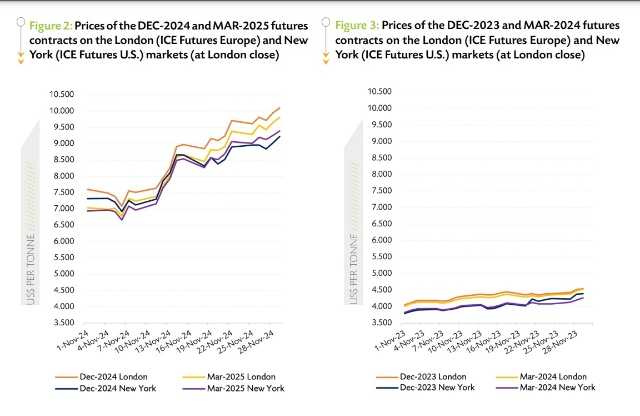ABIDJAN, Côte d’Ivoire – The 2024/25 season started with mixed sentiments regarding cocoa arrivals from top producer, Côte d’Ivoire. Though weekly arrivals are now improving and above the previous season’s levels, the month under review also witnessed a progressive increase in cocoa prices. Figure 1 shows the year-on-year changes in weekly arrivals in Côte d’Ivoire while Figure 2 and Figure 3 illustrate price developments during said month.
As with simple economics whereby an increase in supply almost always leads to a fall in prices, it is generally observed that an increase in arrivals normally leads to bearish cocoa prices. But in Figures 1, 2 and 3, this was not the case in November as both arrivals and prices increased.
From the first week of November to the end of the month, arrivals increased by 76% for the current season as compared to 66% for the same period in the previous season.
With regards to the nearby December contract, in November, London prices increased by 33% as compared to 12% for the 2023/24 season. In New York, in November 2024, prices increased by 26% as compared to 17% in November 2023. Since both arrivals and prices have concurrently increased, supply risks continue to be the focus of attention.
As one may recall, leading cocoa producers, namely Côte d’Ivoire and Ghana rolled over part of the 2023/24 contracts to the current 2024/25 season. As such, though we are currently seeing an improvement in arrivals, the question that comes to mind is – is the cocoa supply enough to cater for both contracts rolled-over from last season in addition to the current season?
Other factors compounding the supply situation include exchange stock levels, weather and Cocoa Swollen Shoot Virus Disease (CSSVD).
Cocoa bean stocks level at the London exchange from the beginning to end of November 2024 decreased by 20% from 26,010 tonnes to 20,770 tonnes. In the United States, exchange stocks dropped by 11% from 114,197 tonnes to 101,639 tonnes over the same time frame. This clearly depicts that stocks are not being replenished.
Recent weather reports point out that temperatures in Côte d’Ivoire and Ghana are currently higher than average temperatures for this time of the year and could pose a risk to crop development. Moreover, with the approaching Harmattan season whose intensity could affect cocoa, there are expectations of a decline in humidity. Dryness has also been reported in Ecuador, the third largest producer. The weather in cocoa growing areas will continue to be monitored.
Furthermore, the prevalence of CSSVD continues to cause havoc for cocoa production in the main producing regions of West Africa. As the region caters for the bulk of global supplies, CSSVD in the region is a force to be reckoned with.
Overall, expectations of a better crop than in the previous season is maintained. The unknown is whether it will be enough to cater for the rolled-over contracts from the previous season and the 2024/25 contracts.



















